What You Need to Know About Chemical Safety

The use of
industrial chemicals in the workplace presents a danger to employees if the
products are not handled safely. OSHA has set up rules requiring the labeling
of chemicals by companies and employee training by employers to minimize the
risk of the chemicals. The Occupational Safety and Health Administration (OSHA)
is tasked to regulate the manufacture and transportation of all materials, including
hazardous ones. When a material is known to present a health or safety hazard, all
materials must be labeled so employees who must work with the material are
aware of its dangers.
Materials
and chemicals that are dangerous can be defined in a number of ways: Toxic
substances that have harmful effects when directly encountered, by-products of
processes, and reactivity of two or more agents can all produce threats to a
worker's well-being. Some substances, like asbestos, were common construction
elements in the past and still linger in workplaces. Some mineral dusts
produced during manufacturing or even coal dust created when burning coal are
considered chemical hazards.
The Hazard
Communication standard requires employers to notify their employees and the
general public when hazardous materials are on the premises. It also requires
testing of all chemicals. If a material is found to be hazardous, that
information must be communicated to employees. One way to do that is to label
containers that carry dangerous material. This OSHA standard pre-empts any
state statute concerning the labeling of chemicals.
In pursuant to
OSHA’s mandated safety regulations, all containers filled with hazardous materials must be
tagged, labeled or marked with the name of all chemicals in the compound,
applicable warnings and the name and address of the manufacturer or importer.
OSHA-required labeling must not interfere with other labeling laws set by the
Department of Transportation or the Hazardous Materials Transportation Act. The
label must be in legible and must be displayed prominently on the
container.
Warnings
must be featured on these hazardous material tags.
Warning messages on these hazardous material tags may consist of words, pictures or
symbols. The warning message must provide, at a minimum, general information about the
dangers of the chemicals. This information, together with required safety
training, lets employees know of the potential hazards associated with the
chemicals they are working with.
OSHA’s
protective measures necessitate protection and education. OSHA has established requirements for
chemical substance and practices concerning safety and protective measures. Safety
equipment such as goggles, gloves, protective coats, and respiratory gear are
required where and when applicable. Standards also exist for informing
employees and others of any possible hazard in the workplace. These steps
include container labeling, employee training and material safety data sheets.
Signage listing the potential health risks that substances pose must be posted
in plain sight if hazardous chemicals are present.
Idesco Safety helps you take safety measures against impending danger is the first step towards avoiding perilous
circumstances at workplaces. Hazardous Material Tags are designed to promote chemical safety
at workplaces, factories, and laboratories.
These laminated safety tags can help keep your facility safe from
hazardous materials and prevent injuries resulting from them. Available with different legends, you can
choose the message that meets with individual requirements and communicates the
intended message. All laminated safety tags are made with hard-matte finish which retain retains
pencil notations, yet can be erased easily. These laminated safety tags can be laminated to offer
protection against water, chemicals, and weather. Hazardous Material tags are resistant to solvents, moisture, abrasion,
fading etc.